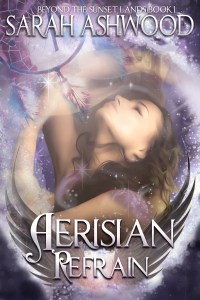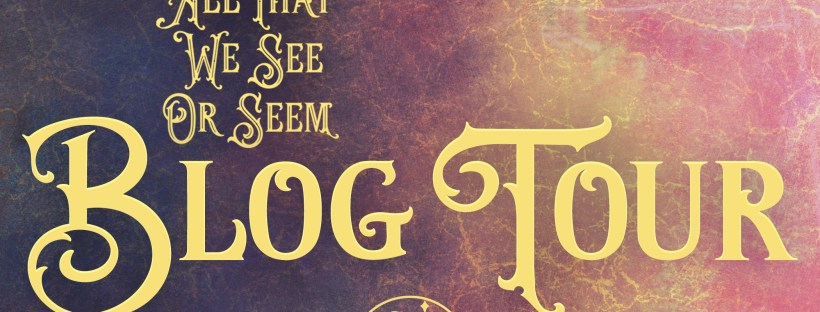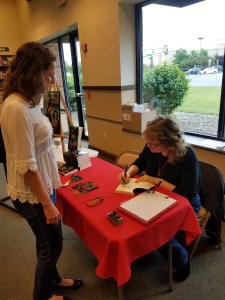Let’s welcome fantasy author Sarah Ashwood to Jilligan’s Island. Her newest book Aerisian Refrain just released — the Facebook party is on Thursday! Stop by to play fun games and win bookish prizes! Welcome, Sarah!
Hi,
When Jill kindly offered me a spot on her blog to chat about my new book, Aerisian Refrain, I struggled with what to say. Of course, I could try to tell you the plot without giving away spoilers. (Unless you happen to be like me and actually like spoilers.) A friend suggested I highlight what’s unique about this book, so let me go there.
To begin with, my MC, Annie Richards, is from Oklahoma and is part Cherokee. I’m a lifelong Okie myself, and grew up in the part of the state where the Cherokee nation has its capital. When I realized Annie was going to be from Oklahoma and was part Cherokee, I knew I had to delve into Cherokee culture and heritage and weave elements of that into my story. It was hard to narrow down all the figures I came across, but I finally settled on three that absolutely fascinated me. The first was a Kâ’lanû Ahkyeli’skï: a Raven Mocker. This creature is scary. I read up on stories about Raven Mockers that had me looking over my shoulder at night. (I get spooked easily.) Check out this moment from Aerisian Refrain when Annie first encounters the Kâ’lanû Ahkyeli’skï :
The raven-like cry of a Kâ’lanû Ahkyeli’skï, which is where the Raven Mocker earns its name, means someone is going to die—much like banshees in Irish folklore. Often, they appear when a person is dying to steal and consume the liver or the heart. Sometimes they torture and kill their victim by cutting open the head, then eating the heart. A year is added to their life for every year their victim would have lived, making a Raven Mocker almost immortal, and accounting for their appearance as an old, wizened man or woman when in human form. They can fly through the air in fiery bird shape, trailing sparks while in the sky. They are usually invisible, except to the most powerful of magic workers. Only a medicine man or woman of much training and strength can stand against them, which meant I was in serious danger.
The other two characters I chose to feature are a little more benevolent. One group was the Thunderers, who the Cherokee believe are storm spirits that live in the sky. The other was a Stoneclad, or rock giant. I loved the Stoneclad. He almost made me think of a Marvel character. There weren’t tons of descriptions of Stoneclads, but most of my research indicated they’re giants that wear a suit of armor fashioned from stone. Like the Thunderers, they aren’t feared—certainly not like the Raven Mockers. In fact, there are stories of them coming to the aid of the Cherokee. As Annie explains in Aerisian Refrain when she’s discussing her people’s folklore,
“I remember Grandma telling me about the Stoneclads: rock giants, and the Aniyvdaqualosgi or Ani-Yuntikwalaski. Those are the Thunderers, or powerful storm spirits. If they took a shape, it was usually human, and they were okay with people. I guess it’s no wonder we’d have legends about great storm spirits, living in Tornado Alley.”
At this point in the book, Annie has no idea she’s going to actually encounter rock giants or storm spirits, and she’s in a for a big surprise when she does!
So there you go—a little peek into what I feel makes my book baby unique. I hope you’ll check out Aerisian Refrain. If you do, I hope you enjoy it! I had so much fun researching the stories of the Cherokee and weaving just a few elements from their rich traditions into this novel. If you’d like to research any of this further, some of my favorite sources were http://www.native-languages.org/ , www.cherokeeregistry.com , www.firstpeople.us , and http://www.sacred-texts.com/nam/index.htm.
Thanks for reading this post and giving me a little of your time. Have a great day!
____________________________________________________________________
Thanks, Sarah! Here’s a little more about the book and the author.

On Earth, Annie’s voice brought her fame and fortune. In Aerisia, her voice brings her magic, but the cost of that power might mean the destruction of Aerisia itself.
Following the prophesied Artan’s victory over the Dark Powers, the land of Aerisia is finally at rest, until ancient beings, long imprisoned, begin to stir…
Eight years after Annie Richards’ stellar voice and musical talents skyrocketed her from rural Oklahoma to international fame, haunting visions have begun threatening her sanity. While she’s returning to her childhood home to convalesce, creatures straight from her nightmares bring down her plane. Annie wakens in a parallel world, Aerisia. Here, she discovers her musical gifts translate into magical powers—the legacy of a banished race who have been invading her dreams.
Mistrusted by Aerisia’s most powerful factions because of her heritage, Annie finds allies are hard to come by. Supporting her are one Simathe warrior, Cole, who refuses to label her as evil, and one woman willing to stand against anything and anyone to help a friend: the Artan herself. Seizing control of her destiny will mean defying both her ancestors and the Aerisian leaders. Mastering her magic may mean making the greatest sacrifice of all…or risk becoming the reason Aerisia itself is torn apart.
Find Aerisian Refrain on Amazon and Goodreads.
 Don’t believe all the hype. Sarah Ashwood isn’t really a gladiator, a Highlander, a fencer, a skilled horsewoman, an archer, a magic wielder, or a martial arts expert. That’s only in her mind. In real life, she’s a genuine Okie from Muskogee who grew up in the wooded hills outside the oldest town in Oklahoma and holds a B.A. in English from American Military University. She now lives (mostly) quietly at home with her husband and three sons, where she tries to sneak in a daily run or workout to save her sanity and keep her mind fresh for her next story.
Don’t believe all the hype. Sarah Ashwood isn’t really a gladiator, a Highlander, a fencer, a skilled horsewoman, an archer, a magic wielder, or a martial arts expert. That’s only in her mind. In real life, she’s a genuine Okie from Muskogee who grew up in the wooded hills outside the oldest town in Oklahoma and holds a B.A. in English from American Military University. She now lives (mostly) quietly at home with her husband and three sons, where she tries to sneak in a daily run or workout to save her sanity and keep her mind fresh for her next story.
Sarah’s works include the Sunset Lands Beyond trilogy and the fantasy novella Amana. To keep up to date with Sarah’s work and new releases, sign up for her newsletter. You can also visit her website, or find her on Facebook, Pinterest, Instagram, and Twitter.



 Every night, seventeen-year-old Reeve Lennox finds herself under a noose.
Every night, seventeen-year-old Reeve Lennox finds herself under a noose.
 JM: Hi, Savannah! Thanks for stopping by. I love the cover of After. Where did you get the idea for the story?
JM: Hi, Savannah! Thanks for stopping by. I love the cover of After. Where did you get the idea for the story?
 Savannah Jezowski lives in a drafty farmhouse in Amish country with her Knight in Shining Armor, a wee warrior princess, and two English Springer Spaniels. She is the author of When Ravens Fall and The Neverway Chronicles. Her work has been published in Ray Gun Revival, Mindflights and in the student publication of Fountains at Pensacola Christian College. She is also a featured author in Five Enchanted Roses from Rooglewood Press and Mythical Doorways, a Fellowship of Fantasy Anthology. She likes books, faeries, writing hats, and having tea with her imaginary friends.
Savannah Jezowski lives in a drafty farmhouse in Amish country with her Knight in Shining Armor, a wee warrior princess, and two English Springer Spaniels. She is the author of When Ravens Fall and The Neverway Chronicles. Her work has been published in Ray Gun Revival, Mindflights and in the student publication of Fountains at Pensacola Christian College. She is also a featured author in Five Enchanted Roses from Rooglewood Press and Mythical Doorways, a Fellowship of Fantasy Anthology. She likes books, faeries, writing hats, and having tea with her imaginary friends.
 Today on Jilligan’s Island, we’re participating in the blog tour for Tabitha Caplinger’s The Chronicle of the Three Trilogy. We’ve got beautiful images, an awesome-sauce book blurb, and a fascinating author bio. So sit back, relax, and learn more about #TCO3!
Today on Jilligan’s Island, we’re participating in the blog tour for Tabitha Caplinger’s The Chronicle of the Three Trilogy. We’ve got beautiful images, an awesome-sauce book blurb, and a fascinating author bio. So sit back, relax, and learn more about #TCO3! Zoe thought the loss of her parents would be the most difficult thing she’d ever have to endure. When she began seeing things she couldn’t explain in her new home of
Zoe thought the loss of her parents would be the most difficult thing she’d ever have to endure. When she began seeing things she couldn’t explain in her new home of
 TCO3: Eden Sword: The final showdown is fast approaching, and a grief-stricken Zoe is forced to count the cost of her destiny. As the losses mount, her strength wanes. Even if the Chosen find the Eden Sword in time, will Zoe be strong enough to wield it? Will she be able to
TCO3: Eden Sword: The final showdown is fast approaching, and a grief-stricken Zoe is forced to count the cost of her destiny. As the losses mount, her strength wanes. Even if the Chosen find the Eden Sword in time, will Zoe be strong enough to wield it? Will she be able to Want to know a little more about the author? Well, Tabitha Caplinger is a wife, mom, youth pastor, and professed TV addict. It’s seriously a problem, but she doesn’t plan on getting help anytime soon. Mostly because she loves the stories. She can’t help but get lost in the worlds created and
Want to know a little more about the author? Well, Tabitha Caplinger is a wife, mom, youth pastor, and professed TV addict. It’s seriously a problem, but she doesn’t plan on getting help anytime soon. Mostly because she loves the stories. She can’t help but get lost in the worlds created and Hi all! I was tagged by the lovely
Hi all! I was tagged by the lovely 
 Recently, a friend posted about a signing she was having and asked how to set up her table. So I should thank her for inspiring this post (thanks, Laurie!)
Recently, a friend posted about a signing she was having and asked how to set up her table. So I should thank her for inspiring this post (thanks, Laurie!) A poster with your beautiful book cover because, well, just look at it! Why wouldn’t you want it in a larger format? This visual may be all that’s needed to garner another sale–because even though we shouldn’t, many do judge a book by its cover and choose to buy only on this point alone.
A poster with your beautiful book cover because, well, just look at it! Why wouldn’t you want it in a larger format? This visual may be all that’s needed to garner another sale–because even though we shouldn’t, many do judge a book by its cover and choose to buy only on this point alone. Dear younger me
Dear younger me Dear younger me
Dear younger me

 An avid reader since birth (her parents claim she often kept them up late begging to hear just one more story), Laurie Lucking discovered her passion for writing after leaving her career as an attorney to become a stay-at-home mom. She writes young adult fantasy with a strong thread of romance, and her debut novel, Common, releases in 2018 from Love2ReadLove2Write Publishing. Laurie is the secretary of her local ACFW chapter and a co-founder of www.landsuncharted.com, a blog for fans of clean young adult speculative fiction. A Midwestern girl through and through, she currently lives in Minnesota with her husband and two young sons. Find out more about Laurie and her writing by visiting www.laurielucking.com.
An avid reader since birth (her parents claim she often kept them up late begging to hear just one more story), Laurie Lucking discovered her passion for writing after leaving her career as an attorney to become a stay-at-home mom. She writes young adult fantasy with a strong thread of romance, and her debut novel, Common, releases in 2018 from Love2ReadLove2Write Publishing. Laurie is the secretary of her local ACFW chapter and a co-founder of www.landsuncharted.com, a blog for fans of clean young adult speculative fiction. A Midwestern girl through and through, she currently lives in Minnesota with her husband and two young sons. Find out more about Laurie and her writing by visiting www.laurielucking.com. Welcome to Jilligan’s Island! Today we’re interviewing T.J. Akers, who stopped by on his blog tour to talk about The Final Paladin, which releases on November 14th. At the end of this interview, I’ll include the book blurb and some interesting information about T.J., as well as the Facebook party link. You’ll want to get your hands on this story. I started reading it last night and was immediately intrigued!
Welcome to Jilligan’s Island! Today we’re interviewing T.J. Akers, who stopped by on his blog tour to talk about The Final Paladin, which releases on November 14th. At the end of this interview, I’ll include the book blurb and some interesting information about T.J., as well as the Facebook party link. You’ll want to get your hands on this story. I started reading it last night and was immediately intrigued!